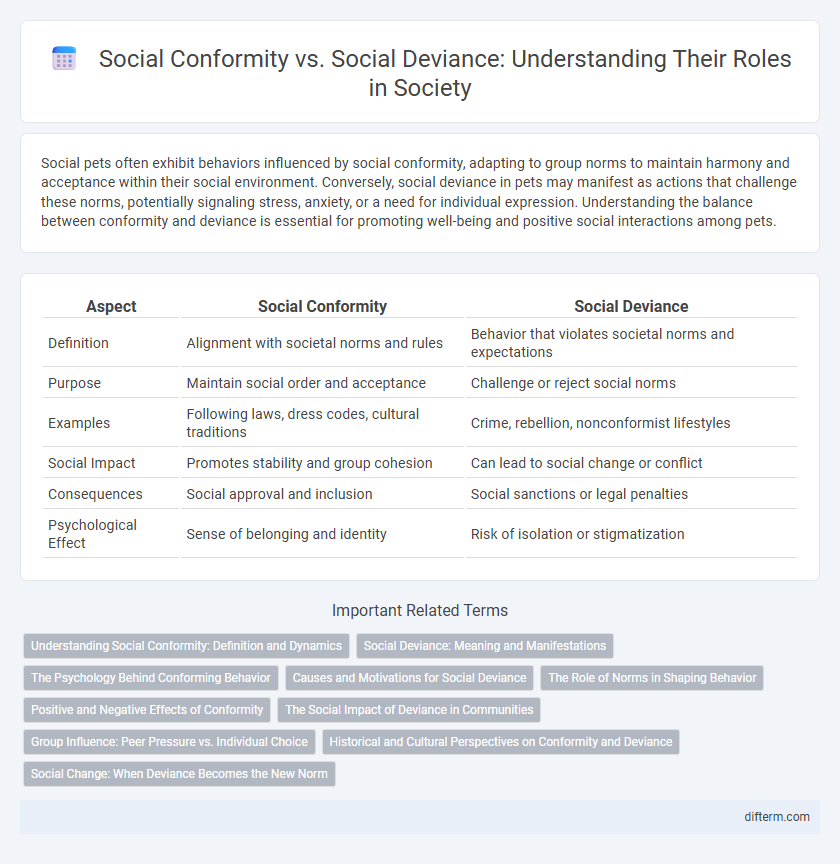Social pets often exhibit behaviors influenced by social conformity, adapting to group norms to maintain harmony and acceptance within their social environment. Conversely, social deviance in pets may manifest as actions that challenge these norms, potentially signaling stress, anxiety, or a need for individual expression. Understanding the balance between conformity and deviance is essential for promoting well-being and positive social interactions among pets.
Table of Comparison
| Aspect | Social Conformity | Social Deviance |
|---|---|---|
| Definition | Alignment with societal norms and rules | Behavior that violates societal norms and expectations |
| Purpose | Maintain social order and acceptance | Challenge or reject social norms |
| Examples | Following laws, dress codes, cultural traditions | Crime, rebellion, nonconformist lifestyles |
| Social Impact | Promotes stability and group cohesion | Can lead to social change or conflict |
| Consequences | Social approval and inclusion | Social sanctions or legal penalties |
| Psychological Effect | Sense of belonging and identity | Risk of isolation or stigmatization |
Understanding Social Conformity: Definition and Dynamics
Social conformity refers to the act of matching attitudes, beliefs, and behaviors to group norms, influenced by social pressure and the desire for acceptance. Dynamics of conformity include normative influence, where individuals conform to gain approval, and informational influence, where they conform due to uncertainty and the need for guidance. This behavior plays a critical role in maintaining social order but can also suppress individuality and innovation.
Social Deviance: Meaning and Manifestations
Social deviance refers to behaviors or actions that violate established social norms and expectations, challenging societal standards through acts such as crime, rebellion, or nonconformity. Manifestations of social deviance include criminal activities, subcultural movements, and unconventional lifestyle choices that disrupt social order and provoke varying reactions from enforcement agencies and the community. Understanding social deviance involves analyzing its causes, social functions, and the dynamic interaction with societal control mechanisms.
The Psychology Behind Conforming Behavior
Conforming behavior stems from the human need for social acceptance and belonging, driven by the psychological mechanisms of normative influence and informational influence. People conform to group norms to avoid social rejection, reduce uncertainty, and gain approval, often internalizing these norms as part of their self-concept. This psychological process highlights the balance between maintaining social harmony and the tension that arises when individual beliefs conflict with group expectations.
Causes and Motivations for Social Deviance
Social deviance arises from factors such as individual desires for autonomy, resistance to societal norms, and reactions to social inequalities like poverty or discrimination. Psychological motivations include the need for identity, acceptance within subcultures, and responses to perceived injustice or oppression. Structural causes like weak social bonds, lack of social support, and limited legitimate opportunities often contribute to deviant behaviors.
The Role of Norms in Shaping Behavior
Social norms function as unwritten rules guiding individual behavior within a community, promoting conformity by establishing expectations for acceptable conduct. When norms are internalized, they reinforce social cohesion, while deviation from these norms can result in sanctions or social exclusion. The dynamic interplay between conformity and deviance highlights the power of normative frameworks in shaping social identity and group membership.
Positive and Negative Effects of Conformity
Social conformity fosters group cohesion and promotes social harmony by encouraging individuals to align their behaviors with collective norms, enhancing cooperation and predictability. However, excessive conformity can stifle creativity, suppress individuality, and perpetuate harmful or unethical practices within societies. Balancing conformity with critical thinking is essential to ensure positive social outcomes while preventing conformity from leading to social stagnation or injustice.
The Social Impact of Deviance in Communities
Social deviance challenges established norms, often prompting communities to reevaluate shared values and boundaries. This process can lead to both social cohesion by reinforcing norms through collective disapproval and social change by introducing alternative perspectives. The impact of deviance on communities influences social control mechanisms, identity formation, and the evolution of cultural standards.
Group Influence: Peer Pressure vs. Individual Choice
Social conformity often arises from peer pressure, where group influence encourages individuals to align their behaviors and attitudes with the majority to gain acceptance and avoid rejection. In contrast, social deviance highlights individual choice when people deliberately act against group norms, asserting personal autonomy despite potential social sanctions. The dynamic between peer pressure and individual decision-making shapes social identity and group cohesion within communities.
Historical and Cultural Perspectives on Conformity and Deviance
Historical and cultural perspectives reveal that social conformity and deviance are deeply influenced by prevailing norms and power structures within societies. In many ancient civilizations, conformity was enforced through rigid caste systems and religious doctrines, while deviance often resulted in severe punishments or ostracism, highlighting the role of culture in defining acceptable behavior. Cross-cultural studies show that behaviors labeled as deviant in one society may be normative in another, emphasizing the importance of historical context in understanding social regulation and resistance.
Social Change: When Deviance Becomes the New Norm
Social conformity stabilizes societies by promoting shared norms, yet social deviance can trigger significant shifts when unconventional behaviors gain acceptance and alter cultural standards. Historical movements illustrate that once-deviant actions, like civil rights activism or technological innovation, often catalyze social change and redefine norms. The dynamic interplay between conformity and deviance drives societal evolution, enabling new values to emerge as dominant.
social conformity vs social deviance Infographic

 difterm.com
difterm.com